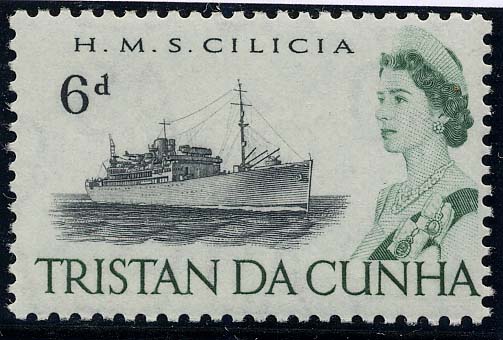
The Cilicia was built for the Anchor Line in 1938 by the Fairfield Shipbuilding and Engineering Co., Ltd., Glasgow; A vessel of 11,172 gross tons (10,287 tons deadweight), her twin screws driven by two 4-cylinder Doxford oil engines developing 10,200 b.h.p. give her a speed of 16.25 knots. She has accommodation for 300 first-class passengers and has a crew of 233.
Taken over by the Admiralty on August 31, 1939, the Cilicia served for 41 years as an armed merchant cruiser. Then in March 1944 she was taken in hand at Mobile for conversion to a troopship, work which was completed in the following September.
On March 25, 1941, while on patrol in the Atlantic, the Cilicia received a radio message from another Anchor Line ship, the Britannia, reporting that she was being attacked by a surface raider. The surgeon in the Cilicia was Dr. Thomas Miller, whose daughter was surgeon in the Britannia. As no further signal was received it was clear that the raider's attack had been successful.
Three days later the Cilicia sighted a small steamer at 6.25 a.m. and at 7.15 a.m. sent away a boarding party to investigate her. She proved to be the Spanish steamer Bachi, and a signal came from the boarding officer that she had picked up survivors from the Britannia. By 9.30 am. they were alongside the Cilicia and first to reach the deck was Dr. Nancy Miller, to be greeted by an overjoyed father. The survivors were landed at Freetown and Dr. Nancy Miller received the M.B.E. in 1942 and Lloyd's Medal in 1943 for her services in attending the passengers and crew of the Britannia during the shelling and sinking of the vessel by a German raider.
During her service as an armed merchant cruiser, the Cilicia was in collision with the Cunard liner Carinthia, also serving in the same capacity. The Carinthia cut into the Cilicia almost to her centreline in way of No. 2 hold and left her jackstaff on board. But for the fact that the Cilicia, like all armed merchant cruisers, carried a large number of empty drums in her holds for buoyancy purposes she would probably not have been able to make her way back to Belfast. From the position of the collision she left behind a continuous trail of empty drums.
The jackstaff belonging to the Carinthia was retained on board the Cilicia and in fact decorated the ante-room of the wardroom through her service as an A.M.C.
H.M.S. Cilicia is commemorated on the stamp for her duties in connection with the establishment of "H.M.S. Atlantic Isle ", as the meteorological station on Tristan da Cunha was called. Tristan Island is in fact the top of a symmetrical volcanic cone rising to 6,760 ft. above sea level. The meteorological station is established at Edinburgh Settlement, on a small ledge 4'/2 miles long and half a mile wide.
After plans had been formulated for the station, matters were complicated by the Admiralty instruction that wives and families of naval personnel should accompany their husbands and that all members of the party should be most carefully selected. "Job 9" as the operation was called, was some job. It meant the transportation and erection of a township, complete in every respect from babies' napkins to a village pump, together with food supplies, bathrooms, wash-houses, sanitation and a telephone system. The meteorological station itself was only part of the huge task.
In all over 2,000 tons of cargo, exclusive of livestock, was transported from Cape Town to Tristan. As ships could not approach the shore closer than half a mile, everything had to be landed in ships boats on an open beach and in heavy surf. With the possibility of enemy interference always present, the work of discharging cargo was a long and hazardous undertaking for the A.M.C.s allocated to the task. An idea of the weather conditions prevailing can be gained from the fact that when H.M.S. Cilicia discharged the second and main batch of cargo she spent five weeks at the island, during which time only seven days were favourable for landing.
The Cilicia arrived at Tristan da Cunha on May 9, 1942 and landed 1,426 tons of cargo in her own boats in 71/2 working days. She left on June 9, 1942. In 1943 "Job 9" was commissioned as "H.M.S. Atlantic Isle ", tender to H.M.S. Afrikander.As a troopship the Cilicia made her first voyage from Liverpool on December 16, 1944, when she carried 2,400 troops to Port Said. A similar voyage to Mediterranean ports followed. By the end of hostilities she had made four trooping voyages and had carried a total of 16,035 troops and prisoners-of-war. On completion of her service as a troopship, she returned to the Fairfield yard and was refitted for her normal service as a passenger vessel. Info E Argyle SB3/65 SG77
